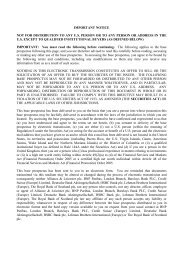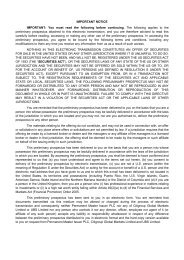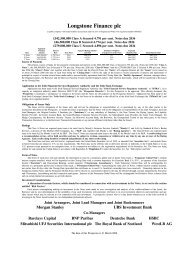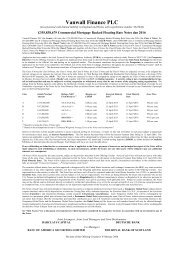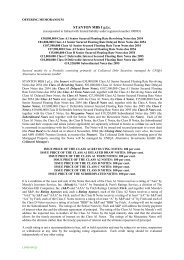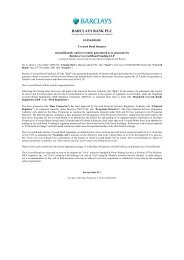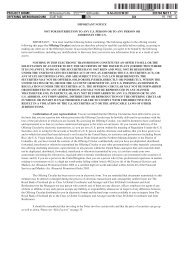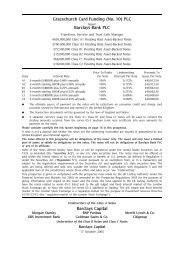Offering Circular. - SFM
Offering Circular. - SFM
Offering Circular. - SFM
You also want an ePaper? Increase the reach of your titles
YUMPU automatically turns print PDFs into web optimized ePapers that Google loves.
THE REGION OF LAZIO<br />
This section is reported herein in its entirety as it appears in the <strong>Offering</strong> Memorandum for the USD<br />
2,000,000,000 Global Medium Term Note Program of the Region dated 6 July, 2004 and all information<br />
provided therein, unless otherwise specifically indicated therein, is as of such date. Such information has not<br />
been independently verified by the Joint Lead Managers, the Issuer, the Originator or any other party to any<br />
of the Transaction Documents (as defined below) or to any of the Interim Documents (as defined below) and<br />
none of the Issuer, the Joint Lead Managers, the Originator, or any other party to any of the Transaction<br />
Documents (as defined below) or to any of the Interim Documents (as defined below) has any responsibility<br />
for the truth, faithfulness, accuracy, completeness and updating thereof or otherwise. None of the Issuer, the<br />
Joint Lead Managers, the Originator or any other party to any of the Transaction Documents (as defined<br />
below) or to any of the Interim Documents (as defined below) has performed or will perform any due<br />
diligence exercise in connection with the Region.<br />
General<br />
The Region of Lazio is located in the central portion of the Republic of Italy (“Italy”) approximately half<br />
way down the Italian peninsula. The Region of Lazio occupies an area of approximately 17,208 square<br />
kilometres (approximately 6,644 square miles) and is divided into five provinces (Frosinone, Latina, Rieti,<br />
Rome and Viterbo). With a population of approximately 5.15 million as of 31 December 2002, representing<br />
approximately 9 per cent. of the Italian population, the Region of Lazio is the third most populated region<br />
in Italy, following the Regions of Lombardia and Campania.<br />
Rome, the capital of Italy, is also the capital of the Region of Lazio and the largest city in Italy. As of 31<br />
December 2002, the city of Rome had a population of approximately 2.8 million people, or approximately<br />
3.2 per cent. of the Italian population according to the 2000 population census.<br />
The principal office of the Region of Lazio is located at Via Rosa Raimondi Garibaldi 7, Rome, Italy.<br />
Relationship between the Central and Local Governments<br />
The Republic of Italy has been a democratic republic since 2 June 1946. Its government is organised<br />
territorially and administratively on national, regional and local levels. Legislative, executive and judicial<br />
powers are exercised at the national level by Italy’s parliament, central government and judicial authorities<br />
(hereinafter together the “Central Government”). Legislative and executive powers are exercised in certain<br />
matters at the local level by regions (regioni, of which there are 20), provinces (province, of which there are<br />
103) and municipalities (comuni, of which there are 8,100). In addition, in the future fourteen metropolitan<br />
cities (città metropolitane) will be established which, once functional, will exercise certain administrative<br />
and executive powers.<br />
Of Italy’s 20 regions, 15 have an ordinary degree of regional autonomy and are referred to as ordinary<br />
regions, while five regions (Friuli-Venezia Giulia, Sicily, Sardinia, Trentino Alto Adige and Valle d’Aosta)<br />
are regulated by special statutes, which provide these regions with greater autonomy and wider legislative<br />
powers, classifying them as special regions. The Region of Lazio is an ordinary region and was established<br />
in 1970.<br />
The Italian Constitution, as amended by the Federalism Law of 18 October 2001 (the “Constitution”),<br />
reserves to the Central Government exclusive powers to act in the following areas: foreign policy and<br />
international relations (including with the EU), asylum rights and status of non-EU citizens; immigration;<br />
relations with religious communities; defence, armed forces and security; currency, financial markets,<br />
competition, monetary policy, tax and accounting systems of the Central Government, protection of savings,<br />
and equalisation of financial resources among the various regions; regulation of Central Government bodies<br />
and Central Government and EU elections; legal and administrative structure of the Central Government and<br />
of national public entities; public order and safety (with the exception of local police); citizenship, civil<br />
status and related registry offices; jurisdictional and procedural laws, civil and criminal legal systems and<br />
administrative justice; establishment of minimum levels of civil and social services to be guaranteed<br />
throughout the nation; general rules on education; national pension funds; regulation of provincial,<br />
38



